A team of former FBI and CIA operatives, the "White House plumbers" were tasked with stopping information leaks that made the president look bad and fighting back against his enemies. Then things went terribly wrong.
On June 17, 1972, a night security guard at the Watergate complex in Washington D.C. noticed that a door had a piece of tape on the latch. This was not usually a cause for concern, as this door was occasionally taped or propped open to allow staff to come and go on breaks. What bothered the guard, however, was that he had noticed the same door with tape earlier that night — and he had fixed it. He called the police.
From a hotel room across the street, two members of the White House Special Investigations Unit — G. Gordon Liddy and E. Howard Hunt — listened to the progress of their infiltration team via radio. On the sixth floor of the Watergate complex, their five burglars were in the process of photographing files and installing secret listening devices in the headquarters of the Democratic National Committee.
But then, a lookout suddenly noticed unfamiliar movement and flashlights on the floor that was above the headquarters. He contacted Liddy via radio and said, “Hey, any of our guys wearin’ hippie clothes?” Liddy responded, “Negative. All our people are in business suits. Why?”
Liddy and Hunt listened as their lookout described what he could see: “They’re on the sixth floor now. Four or five guys. One’s got on a cowboy hat. One’s got on a sweatshirt. It looks like… guns! They’ve got guns.”

Wikimedia CommonsSecurity officer Frank Wills’ log of the Watergate Office Building. June 17, 1972.
Liddy grabbed the radio to make a mike switch. “Are you reading this?” he asked the infiltration team. “Come in!” They did not answer. Liddy squeezed the radio again. His voice was louder this time. “Come in. That’s an order!”
Once again, Liddy received no response. Then, the radio crackled. Finally, a weak, defeated voice on the other end said, “They got us.”
The next morning, D.C. newspapers treated the foiled burglary incident as a stranger-than-fiction local interest story. But thanks to certain strange details — the suspects’ possession of $2,300 in $100 bills, connections to intelligence work, spy-grade listening equipment, and direct ties to President Richard Nixon’s reelection committee — it certainly did not stay that way.
Although we all know it as the “Watergate scandal” today, that June, no one could have suspected that the truth of what those burglars were doing and who they were working for would completely destroy Nixon’s presidency — and reshape America’s politics and history for years to come.
Prelude: A Paranoid President
To fully understand what initiated the Watergate break-in, what it meant, and what its motives were, one needs to begin with Richard Milhous Nixon, the 37th president of the United States of America.
A lawyer raised by working-class Quaker parents in Southern California, Nixon decided to serve in the U.S. Navy during World War II. In 1946, not long after returning to civilian life, he ventured into politics, winning one of California’s seats in the House of Representatives. In 1948, Nixon seized his chance to ride the rising anti-communist “Red Scare” to power.
On August 3, 1948, growing Cold War anxieties kicked into high gear with the testimony of former U.S. Communist Party member Whittaker Chambers before the House Committee on Un-American Activities. According to Chambers, the prominent U.S. official Alger Hiss had been secretly working as a communist spy for the Soviet Union — an explosive accusation.
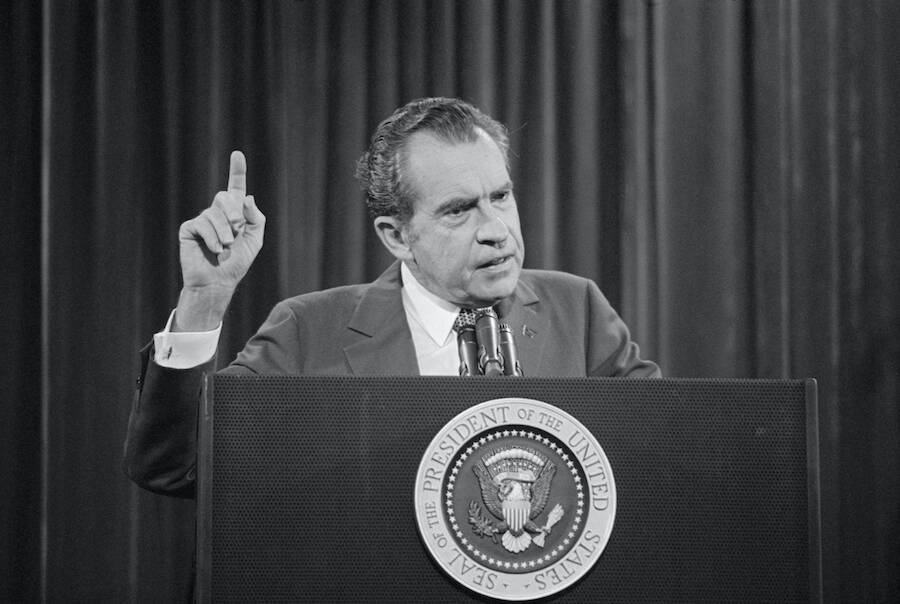
Bettmann/Contributor/Getty ImagesOne of the most memorable moments from the Watergate scandal was Richard Nixon’s infamous “I’m not a crook” speech at Disney World on November 17, 1973.
If Hiss had been working for the Soviets all along, it called all of his decisions — such as shaping the European post-war order as Director of the Office of Special Political Affairs and establishing the United Nations — into question. For those who believed the allegation, the possibility that the Soviets had been manipulating American policy was as conceivable as it was terrifying.
Hiss wasted no time in offering his rebuttal. Appearing before Congress just two days after Chambers, he claimed that he’d never been a communist or even met his accuser before. Most congressmen were satisfied with what he had to say and even President Harry S. Truman called the claims a “red herring.” Against the prevailing sentiment in the Capitol, however, Nixon found Hiss to be “condescending” and “insulting in the extreme.”
In turn, Nixon went after Hiss with such ferocity that it earned him the sobriquet “bulldog” and the attention of the future Republican presidential nominee, Dwight D. Eisenhower — who chose Nixon as his running mate.
So Close And Yet So Far From Power
John Adams famously called the vice presidency “the most insignificant office that ever the Invention of Man contrived or his imagination conceived.”
Still, Nixon seems to have excelled in the position. Following Eisenhower’s presidential election in 1952, Nixon soon became involved with the National Security Council. The vice president quickly found common ground with members of the CIA over their shared hatred for communism.
According to E. Howard Hunt — then a CIA officer who would be tasked with planning the Bay of Pigs operation — Nixon frequently attended and participated in planning meetings for an intended invasion of Cuba following Fidel Castro’s successful communist revolution in the 1950s.
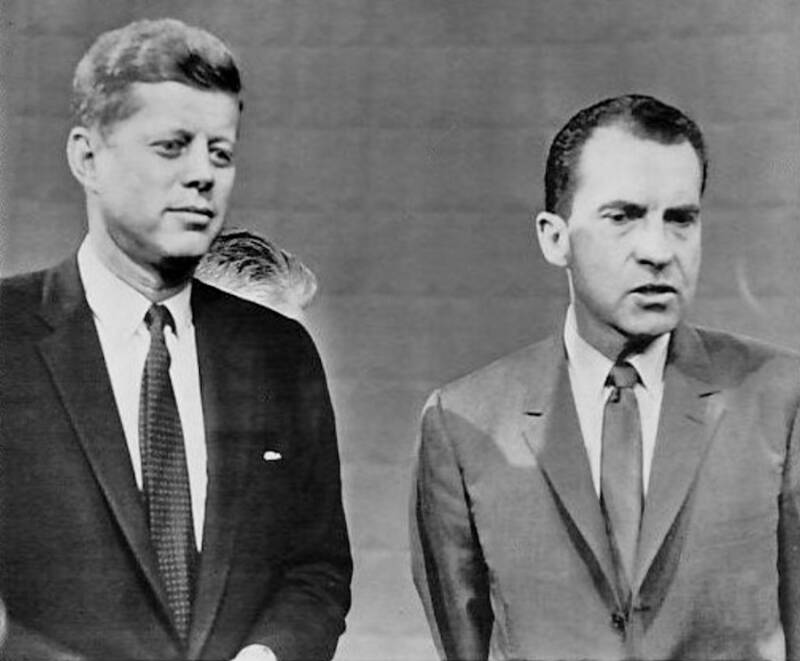
Wikimedia CommonsJohn F. Kennedy and Richard Nixon, pictured prior to their first presidential debate in Chicago in 1960.
On paper, Nixon was the natural choice for the presidency during the 1960 election. But on camera, Americans found him to be sweaty and uncomfortable compared to the dapper and youthful John F. Kennedy.
When the election results came in and Kennedy was declared the winner, disappointment settled into Nixon’s mind — along with the belief that Kennedy had used “dirty tricks” to steal the presidency. In response, Nixon resolved to become a master of the same techniques that had bested him.
The Setting: Why Then And Why Nixon
It’s been argued that 1968, the year of Richard Nixon’s successful presidential election, was the worst year in American history since the Civil War.
In January of that year, President Lyndon B. Johnson doubled down on American involvement in Vietnam during the Tet Offensive, requiring the draft of up to 200,000 new troops. As countless Americans watched on their television screens, the war grew deadlier. In February, 543 American soldiers were killed and more than 2,500 were wounded — in a single week.
And in March, 26 American soldiers killed more than 500 Vietnamese civilians in the My Lai Massacre. Meanwhile, Robert F. Kennedy (the brother of the assassinated John F. Kennedy), announced that he would run against his party’s incumbent President Johnson, and promised to end the war.
Seeing the writing on the wall, Johnson soon announced that he would not seek reelection. Whatever sense of calm that might have brought to the situation did not last. Just a few days later, on April 4, 1968, Martin Luther King Jr. was assassinated in Memphis, Tennessee. Riots exploded in nearly every major city across the United States. For many Americans watching these events on television, it seemed as if they would never stop.

Wikimedia CommonsRiot damage following Martin Luther King Jr. assassination protests in Washington, D.C. 1968.
Meanwhile, the Vietnam War continued to become more and more unpopular. The growth of the broader anti-war movement, as well as groups like the Black Panthers, the Yippies, and the Students for a Democratic Society, culminated in a year of seemingly endless protests.
Things only got worse in June. Mere moments after leaving the stage from his victory speech at the California Democratic presidential primary, Robert F. Kennedy was shot and killed by the assassin Sirhan Sirhan. The shock of losing the presidential election favorite so suddenly, so soon after the death of Martin Luther King Jr., with the assassination of John F. Kennedy still fresh in the collective consciousness was like a spark in a powder keg.
By the Democratic National Convention in August, mass demonstrations had devolved into bloody clashes with police as young people and activists poured into Chicago to protest the Vietnam War, the recent assassinations of multiple civil rights leaders, and the Democratic establishment.
Against this backdrop, many Americans felt that Richard Nixon — quiet, pragmatic, and the former vice president of a popular administration — promising “law and order” was most likely to get the country back on track. And so he was elected that November. But even though he had been a capable statesman, Nixon struggled to operate under a new level of pressure, especially with such a vocal and visible political opposition.
Known for being temperamental, it was likely only a matter of time before Nixon’s paranoia, his drinking, and his lingering Red Scare fears about subversive plots within the government spilled over into his administration.
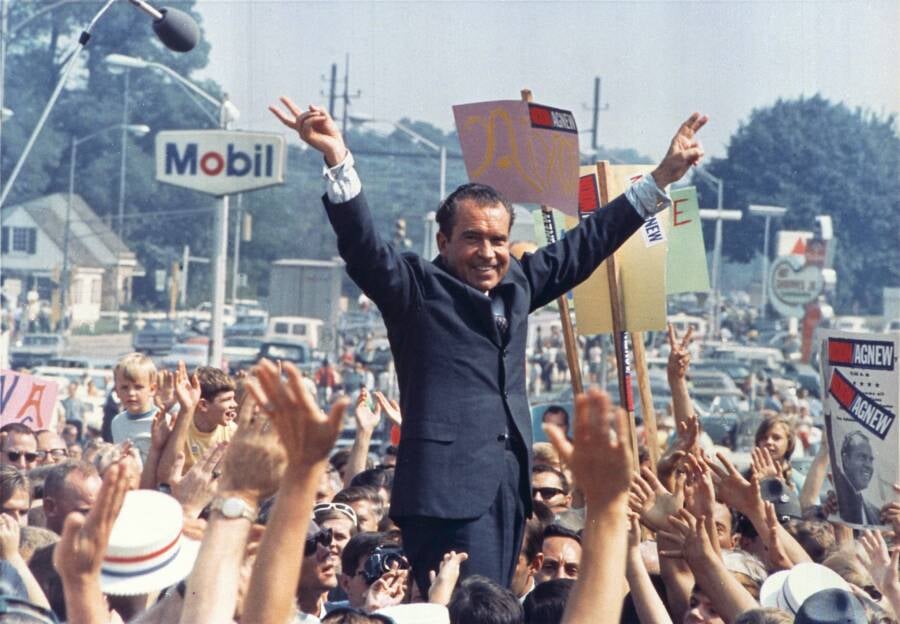
Wikimedia CommonsRichard Nixon, pictured on the campaign trail in 1968.
As fate would have it, Nixon’s first term coincided with the kind of chaos that would have tested the best of presidents. In 1969, the largest mass protests against the Vietnam War took place just outside the White House.
In the early 1970s, the group Weather Underground — a radical off-shoot from Students for a Democratic Society — launched a bombing campaign against multiple military and government facilities around the country, including a successful bombing at the U.S. Capitol building in 1971.
The same year, military analyst Daniel Ellsberg leaked the Pentagon Papers to the press. They were secret government studies on the situation in Vietnam that revealed to the American public for the first time how much they didn’t know and how little progress they were making in the war.
That may have been the final straw that pushed Nixon to pull a secret team.
Inside The White House Special Investigations Unit, AKA The White House Plumbers
Charles Colson was the Special Counsel to Richard Nixon from 1969 to 1970. What Colson called himself, however, was Nixon’s “hatchet man.”
He was particularly adept at getting things done, even if they were unpleasant. Tasked with the creation of a clandestine intelligence organization under the authority of the executive branch — a group to stop information leaks and dig up information about Nixon’s enemies — Colson had a lucky break. He already knew of a “retired” CIA agent named E. Howard Hunt, who may or may not have been looking for a job.
The exact timeline of Hunt’s job history is so murky that the FBI spent weeks investigating it during his pardon application review in the 1980s. During World War II, Hunt had been either a U.S. Army Air Corps or an Office of Strategic Services officer (or both), and then a CIA agent starting in 1949.
We know Hunt was in Mexico City in 1951, where he met and presided over William F. Buckley in the agency, and that he played a crucial role in planning the future Operation PBSuccess — the mission that would overthrow the Guatemalan government in 1954. Hunt spent a few more years overseas before returning to Washington, D.C. and overseeing plans to invade Cuba.

Wikimedia CommonsE. Howard Hunt testifies before Congress about Watergate in 1973.
But after the failed Bay of Pigs invasion in 1961, Hunt was one of the unlucky CIA members to be left holding the bag. Although he was not fired, he was reassigned to writing spy novels to improve public opinion on espionage.
As the FBI’s official story goes, sometime in 1970, Robert Mullen, the CEO of a Washington PR firm, received a call from a CIA contact who asked him if he could hire a retiring agent. Mullen, who had received phone calls like this before about other agents, did not find this strange in the least.
In his experience, former intelligence officers had difficulty transitioning into other work because they could not openly talk about their previous experiences with prospective employers. Still, Mullen gave Hunt a shot, a desk, and the assignment of writing educational children’s television shorts.
From here, the CEO and the CIA agent’s stories split.
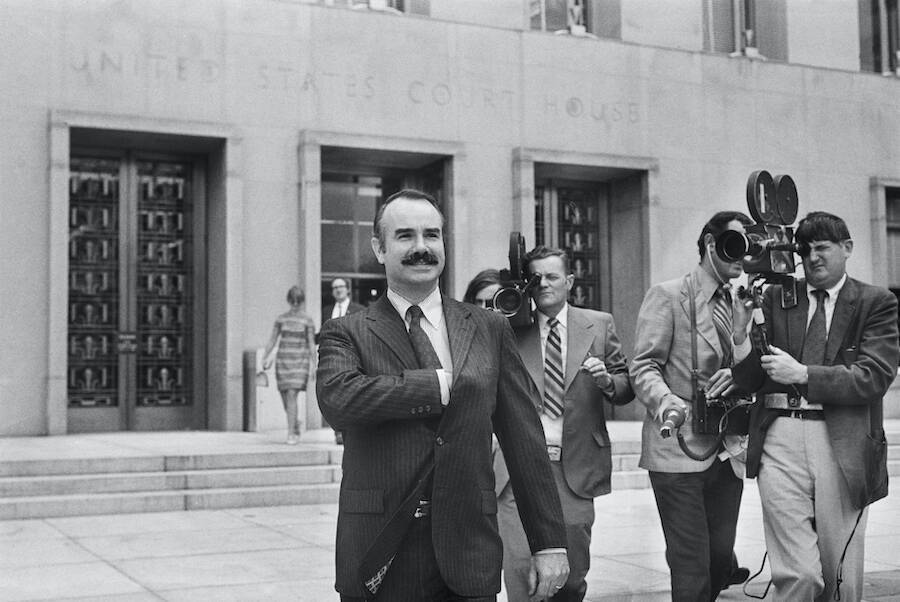
Bettmann/Contributor/Getty ImagesFormer FBI agent G. Gordon Liddy was an “idea man” among the Plumbers and the mastermind behind Watergate.
According to Hunt, he was still working for Mullen all the way up until 1972. But according to Mullen’s FBI testimony, he stopped seeing him at the office at some point in 1971. However, he did not remember why he left. Although the exact date of his departure is unknown, we know Hunt had to have accepted a White House role from Charles Colson sometime during that year because he spent much of it assembling their necessary crew.
Hunt called old contacts from the CIA and the Bay of Pigs to see if they were available for confidential work. Five trusted contacts agreed to join: Bernard Barker, Frank Sturgis, Eugenio Martinez, James McCord, and Virgilio Gonzalez.
And as Hunt recruited these contacts to help him out, another member of the White House Special Investigations Unit, G. Gordon Liddy, served as an operational manager and idea man. A former FBI agent with a history of once admiring Hitler and eating rats, Liddy was one of the primary organizers of Watergate — and was even said to have been the “mastermind.”
Hunt, Liddy, and their CIA assets were key players in the group now remembered as the “Plumbers,” a name with origins in a private joke. Their job was to stop information leaks — and to take down Nixon’s rivals.
More Than One Kind Of Burglar
By and large, the men Hunt assembled had certain shared traits. Three were born and raised in Cuba. Two were formal CIA agents, while all of the others were at least arguably affiliated with the agency. All had been involved in the Bay of Pigs invasion or other anti-Castro activity.
However, there’s an important question one might ask regarding the different individuals involved, the same one Watergate investigators would eventually apply to the Nixon administration itself: Who knew what and when?
For the sake of convenience, using this scheme, the Watergate burglars can be broken down and dealt with using the following categories, based on what we know about their individual motivations.
The Mystery Man: Frank Sturgis
Frank Sturgis, born Frank Fiorini, has one of the most complicated stories to consider of any of the conspirators. It is also the most likely to be wrong. For context, the FBI has yet to fully declassify the file on Sturgis. It is over 75,000 pages long, more than four times the length of their file on Watergate.
Officially, Sturgis was born in Virginia in 1924 and served with the U.S. Marine Corps in the Pacific Theater during World War II. In 1942, Sturgis’ battalion was among those provided to intelligence officer William “Wild Bill” Donovan for the purposes of creating a “guerilla” corps that was better suited to the conditions of the Pacific Front and versed in psychological warfare.
Donovan was the same man who would go on to found and lead the CIA’s predecessor, the Office of Strategic Services (OSS), and recruit E. Howard Hunt as an OSS agent sometime around 1943. Officially, Sturgis was only taught guerilla tactics and was never brought into OSS intelligence work.
To this day, authorities insist that Sturgis was never an official employee of the CIA, just a “soldier of fortune” who appeared at critical moments of agency involvement. But some are skeptical, especially since there was a character in Hunt’s 1949 novel who was similar to Sturgis — and shared his last name. Though Hunt once claimed that he had first met Sturgis shortly before the 1972 Watergate break-in, he later admitted that wasn’t true.
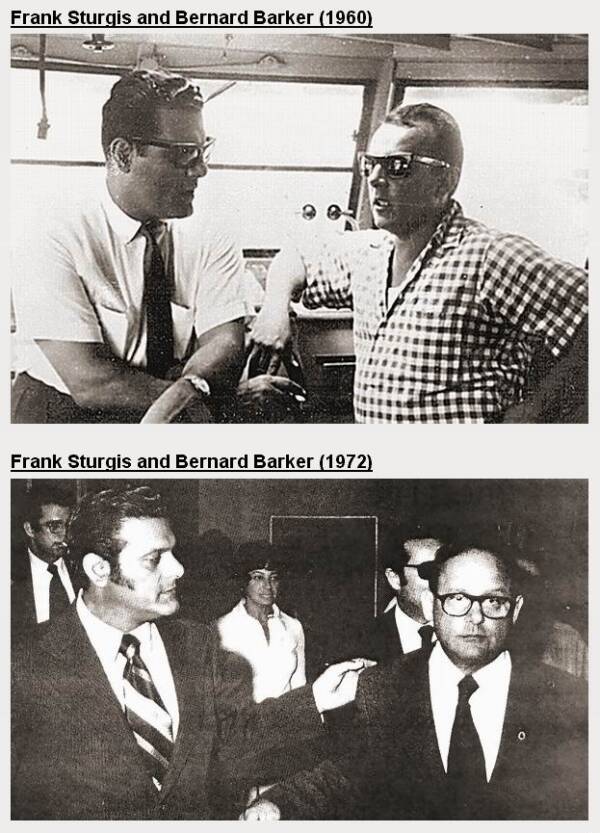
Wikimedia CommonsPlumbers Frank Sturgis and Bernard Barker, photographed together both in 1960 and in 1972, casting doubt about Sturgis’ distance from the other conspirators.
Sturgis moved to Cuba at one of the most turbulent points in the nation’s history in 1956. He was supposedly independently involved in anti-Castro activities during that time. But if he was not officially an American asset, this second strange Sturgis story becomes even harder to explain.
In 1958, Sturgis was arrested in Miami after authorities found evidence linking him to a recently raided Cuban weapons cache that contained “50,000 rounds of ammunition, about 250 guns, including 6 machine guns and 130 rifles, ten hand grenades and a quantity of dynamite.”
Sturgis was charged with illegal possession of arms, but once he bonded out of jail, the case essentially disappeared. As one author summarized: “There is no record of a hearing being brought to bear against them. There is no record of a hearing being conducted and no court date was ever set in Miami, nor any warrants issued for their arrest on these charges after being released from custody. The entire episode seems simply to go away.”
As with everything else in Sturgis’ life, what exactly he was up to before he “officially” met E. Howard Hunt in 1971 is open to speculation. One persistent accusation is that both Sturgis and Hunt were involved in various assassination plots together. In the late 1970s, Marita Lorenz, one of Sturgis’ spy recruits and a purported ex-lover of Fidel Castro, claimed that Sturgis had asked her to put poisonous pills in Castro’s food.
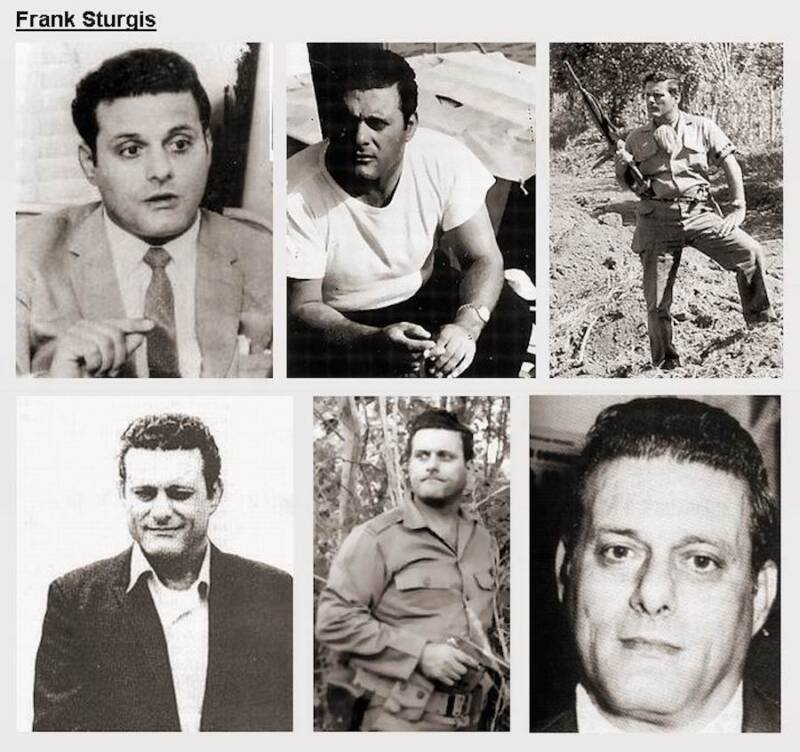
Wikimedia CommonsVarious photos of Frank Sturgis, taken at different points of his mysterious career.
Additionally, Lorenz claimed to have gone with Sturgis to Dallas just days leading up to the 1963 assassination of John F. Kennedy. There, she said that she witnessed Hunt, Sturgis, and the future gunman Lee Harvey Oswald speaking in a hotel room. Lorenz said that she flew out of Dallas on November 21, thus missing the killing on November 22, but long maintained her suspicions about what the men had been planning in the hotel.
In a purported encounter with Sturgis in 1977, Lorenz claimed she asked him directly about Kennedy’s death and if he had played a role in it. Sturgis allegedly responded, “So what if I f*cking did it? Who’s gonna prove it?”
Both Sturgis and Hunt provided alibis in their congressional testimony, but neither one is very solid. Sturgis said he was home in Miami watching television. Hunt’s alibi was only slightly better — that he was with his family that day. However, the only possible corroborating witnesses to this fact would have been his wife — who had died in a plane crash in 1972 — or his son, St. John Hunt, who was just a child at the time of the assassination.
Speaking to Rolling Stone in 2007, St. John Hunt said that the idea that his father would have bothered to spend the day with his wife and children was “just the biggest load of crap in the f*cking world.”

Wikimedia CommonsThe infamous “Three Tramps” photo taken in Dallas shortly after John F. Kennedy’s assassination. Some say that two of the mysterious men look like Sturgis and Hunt.
One piece of potential evidence that St. John Hunt and the authorities have examined was the infamous picture of the “Three Tramps” — three men who were arrested in Dallas on the same day of the assassination. According to St. John Hunt and other observers, one of those tramps looks a lot like E. Howard Hunt and another looks a lot like Frank Sturgis.
Officially, the tramps were later identified as Harold Doyle, Gus Abrams, and John Gedney, three men who had been found in a freight car near the assassination. They had been held as “investigative prisoners” on vagrancy charges and they were released just days later. However, many remain suspicious about their true identities — especially since they were remarkably clean-cut and well-dressed for being so-called vagrants.
For some conspiracy theorists who believe Hunt and Sturgis were two of the “real” tramps, this is evidence that helps explain not just who killed John F. Kennedy, but who Frank Sturgis was. According to these theorists, “soldier of fortune” was a convenient cover story for Sturgis’ real job as a CIA hitman, who was held at arm’s length to provide the agency with deniability.
But if that were true, why would this assassin be sent on a burglary mission?
The Cubans: Martinez, Barker, And Gonzalez
Equally unbelievable, but in a different way, are the interconnected stories of Eugenio Martinez, Bernard Barker, and Virgilio Gonzalez, the Cuban nationals with CIA connections who were captured during the Watergate break-in.
We will largely concern ourselves with Martinez’s entrance into the Plumbers for two reasons. Bernard Barker, while a fascinating character — the Havana-born son of an American man of Russian descent who fought in World War II before joining the CIA organization — was, like Hunt or Sturgis, a more “typical” intelligence operative, if such a thing can be said to exist.
Virgilio Gonzalez and Eugenio Martinez, however, were “assets” who assisted the CIA without officially being part of the organization. As a result, how these anti-Castro revolutionaries became burglars at the center of an American political scandal is the more concerning question. Of those two men, Martinez provided the most detailed account of his Watergate experience in an article that he published in Vanity Fair in 1974.
Eugenio Martinez was born in Cuba in 1922. According to declassified but heavily redacted CIA documents, he was a ship captain recruited by the agency in 1961 to assist in “maritime activity” against the Castro regime.
According to Martinez’s own account, his jobs included “over 350 missions to Cuba for the CIA. Some of the people I infiltrated there were caught and tortured, and some of them talked.” As he continues in another passage: “There would be times when I would take men wearing hoods to Cuba. They might have been my friends. But I did not want to know. Too many of my friends have been caught and tortured and forced to talk.”
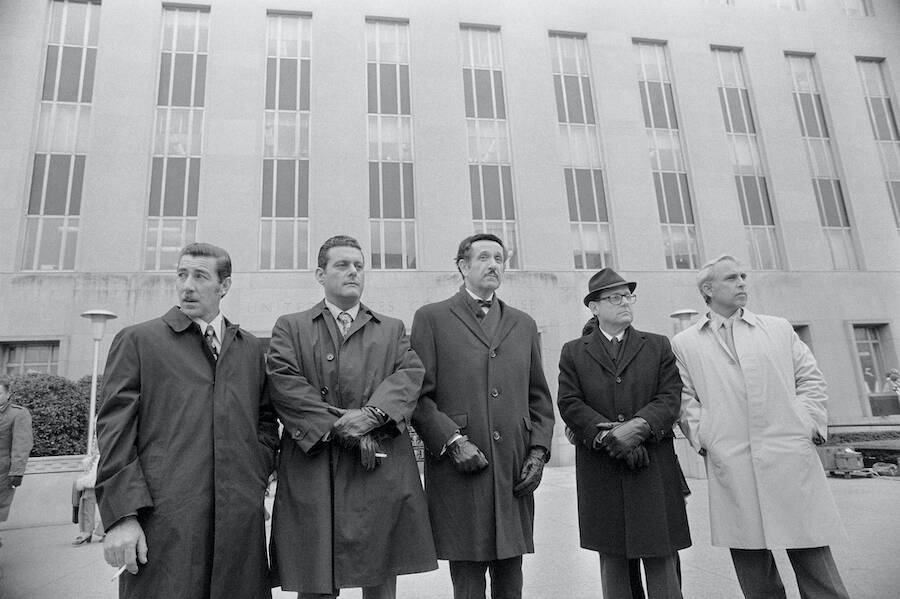
Wally McNamee/Contributor/Getty ImagesFour out of the five Watergate burglars and their attorney at their trial at a district court, pictured from left to right: Virgilio Gonzalez, Frank Sturgis, attorney Henry Rothblatt, Bernard Barker, and Eugenio Martinez.
Following the failure of the Bay of Pigs invasion, Martinez was a wanted man in Cuba. As compensation for his efforts, the CIA paid him a $100-a-month retainer as he settled in Miami, Florida. He also worked as an informant in the Cuban ex-pat community, reporting people of interest to the CIA.
In the CIA archives, the record states that “Mr. Martinez was terminated in absentia on 17 June 1972” — the same day as his arrest at the Watergate complex. The suspiciousness of the timing should raise concerns over the overlap between his service as an active CIA asset and his activities with the Plumbers. And according to Martinez’s account, it was precisely because of this ambiguity that he agreed to join the Plumbers at all.
While Martinez had known fellow Plumber Bernard Barker for years, he had only met E. Howard Hunt on April 16, 1971, the 10th anniversary of the failed Bay of Pigs invasion. That did not mean he had not heard of Hunt, but that he had known him only by his code name “Eduardo.”
Upon meeting, Hunt was introduced as newly “retired” from the CIA. However, Martinez’s reaction makes it clear that retiring from the intelligence community is far more complicated than other industries:
“I knew just what he was saying. I was also officially retired from the Company. Two years before, my case officer had gathered all the men in my Company unit and handed us envelopes with retirement announcements inside. But mine was a blank paper. Afterward, he explained to me that I would stop making my boat missions to Cuba but I would continue my work with the Company.”

Wikimedia CommonsA battlefield image from the Bay of Pigs invasion force. 1961.
Over the course of several meetings, Hunt laid out an assignment for Martinez and Barker. A spy was leaking sensitive documents to the Russians and an exclusive team made up of agents from the FBI and the CIA, overseen by the White House, was being formed to handle the situation. Martinez was honored to be considered and enthusiastically volunteered.
Martinez attempted to touch base with his case officer (CO) at “the Company” to learn more about “Eduardo’s” plan. His CO seemingly had no idea what he was talking about. Because “Eduardo” had already shown him White House stationery as proof, Martinez assumed that this mission was so top secret, it was on a need-to-know basis even within the agency.
With that in mind, by his account, he treated the Plumbers’ break-ins and buggings like any other mission — not asking too many questions and doing what he was told. According to Martinez, he did not even know who Daniel Ellsberg — the leaker of the Pentagon Papers — was as he searched his psychiatrist’s office looking for blackmail material to use against him.
According to Martinez, it was Hunt’s framing of their activities as part of the fight against the Soviet Union and toward Cuban liberation that drew him into the plot and kept him going during future burglaries.
For example, Martinez asserts that Hunt never mentioned “Watergate” during the initial briefings before the infamous break-in. Instead, he claimed to have “information that Castro and other foreign governments were giving money to McGovern,” the 1972 Democratic presidential candidate.
To Martinez, and perhaps some other Plumbers, the Watergate break-in had little to do with preserving Nixon’s power. It was about ending Castro’s.
The Campaign Man: James McCord
On the opposite end of the spectrum is James McCord, the sole member of the Watergate burglars to have been formally employed by the White House.
A former agent of both the FBI and the CIA, McCord had once been in charge of physical security at the CIA headquarters in Langley, Virginia, in addition to likely helping plan the ill-fated Bay of Pigs invasion.
One of the most striking things about James McCord, however, was how much people in positions of authority seemed to like him. Once, the CIA director Allen Dulles introduced McCord to an Air Force colonel, with the uncharacteristically high praise, “This man is the best man we have.”
What people liked about McCord was that he followed orders and he got things done. By contrast, this was exactly the issue McCord initially had with Richard Nixon: He was not “one of us,” or a good team player. However, if these feelings persisted, McCord did not let them get in the way.
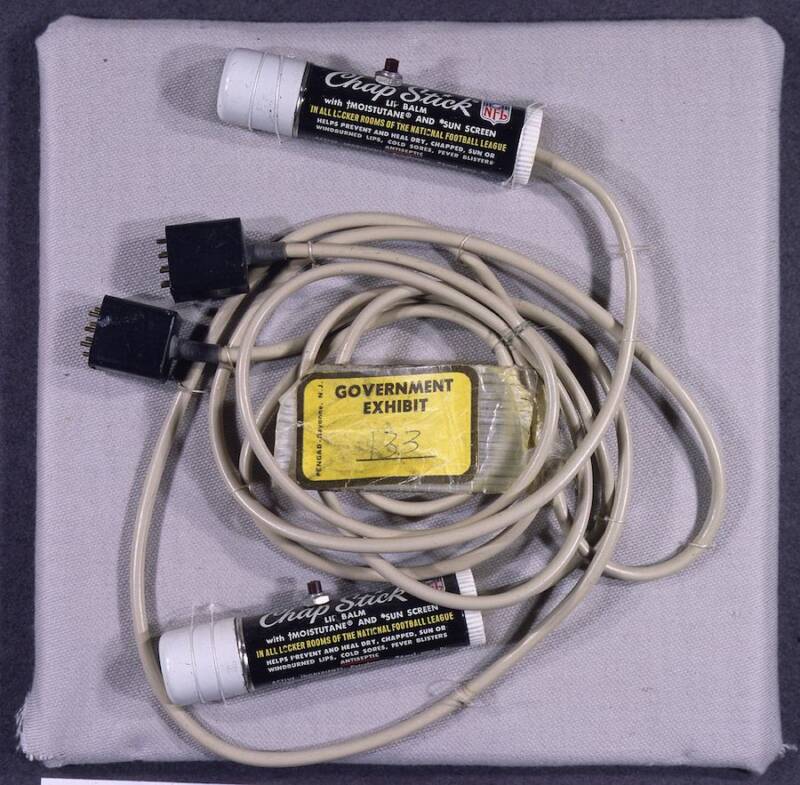
Wikimedia CommonsSpy microphones disguised as Chapstick seized from a safe at E. Howard Hunt’s White House office safe.
Either of his own volition or in coordination with other agency contacts, McCord officially retired from the CIA in 1970. Shortly after starting a private security firm, McCord was approached to provide “solely defensive security work” for both the Committee to Re-Elect the President (later infamously known as CREEP) and the upcoming Republican National Convention.
Given the turbulent political climate, it was understandable for the convention to have been concerned about demonstrations or even outright attacks. But what was not understandable and helped lead the investigation by Washington Post reporters Bob Woodward and Carl Bernstein back to the White House, was that McCord was rarely seen at the convention site, committee headquarters, or convention planning meetings.
McCord’s “defense work” for CREEP, a convenient cover story for his participation in the Plumbers, actually involved maintaining and operating advanced electronic listening devices for the team’s operations. These were the very same devices discovered along with McCord and the four other burglars at the Democratic National Committee headquarters in June 1972.
Bungling A Burglary
Unfortunately for the Plumbers and Richard Nixon’s presidency, using James McCord as part of the office infiltration team was one of the biggest mistakes in the Watergate burglary. In the opposite of all the established practices of espionage, McCord was a provable employee of the Nixon administration with connections to the CIA, the FBI, and CREEP.
Placing McCord — with his agency-grade listening devices — in that room drew direct links between the break-in and the Plumbers’ former employers, the Attorney General John N. Mitchell (who played a crucial role in CREEP), and Richard Nixon as the man who possibly authorized their activities or at least created an environment that allowed them to happen.
There were several reasons why no one noticed this until it was too late.
McCord’s task on June 17, 1972, was to repair or replace faulty listening devices that the team had already placed in the DNC office back in May of that same year. It’s possible that McCord did not trust the other Plumbers to do the job properly on their own or just wanted to see to it himself.
Another aspect may have been the strategic miscalculation that McCord’s presence limited the Plumbers’ overall vulnerability. Logically, a team’s designated electronics expert is most likely the fastest member at repairing electronics. It follows, then, that sending McCord along on the second Watergate break-in could have been seen as an attempt at caution.
It is, of course, also possible the team got too cocky and thought this was a quick, technical tweak on a more-or-less-complete mission. Or, perhaps, it would be fairer to say, “too comfortable” — especially since team members made the mistake of bringing multiple personal belongings to the Watergate complex. One incriminating item was Bernard Barker’s address book.

Wikimedia CommonsThe address book of Bernard Barker, discovered in the Watergate complex after the burglary.
Inside the address book, investigators found an entry for an “HH” with a White House phone number. As if that had not been enough to connect Hunt to the crime, they found the same number listed in another burglar’s address book — and a check from Hunt, made out to a country club.
Adding insult to injury, the Watergate break-in’s most famous blunder — the taped door and its discovery — was equally unnecessary on multiple levels.
First, James McCord taped the door the wrong way. While a horizontal strip and a vertical strip of duct tape would have both stopped the door from locking, the door could have hidden a vertical strip of duct tape. Despite this, McCord placed the tape horizontally both times, with enough excess left in plain sight that a security guard caught onto the burglars twice.
Second, to the outside observer, there would have been no clear reason why the burglars would’ve needed to tape the door if they were already inside the building. So it was soon obvious that this was no ordinary burglary.
Breaking Down A Presidency
The full story of how Richard Nixon went from winning the 1972 reelection in a landslide to flying away on a helicopter after his resignation in 1974 is outside the scope of this post. Still, it’s worth noting that the administration insisted from the beginning that they had no involvement in the burglary. But it was only a matter of time before the tables began to turn.
After all, investigative journalists began to put the pieces together the morning after the burglary. And on June 19, 1972, Carl Bernstein and Bob Woodward published the first installment in their regular coverage of Watergate, updating readers with their new discoveries about the break-in.
Thanks to the many traces the Plumbers left behind, the Washington Post reporters found a major piece of evidence in less than two months.
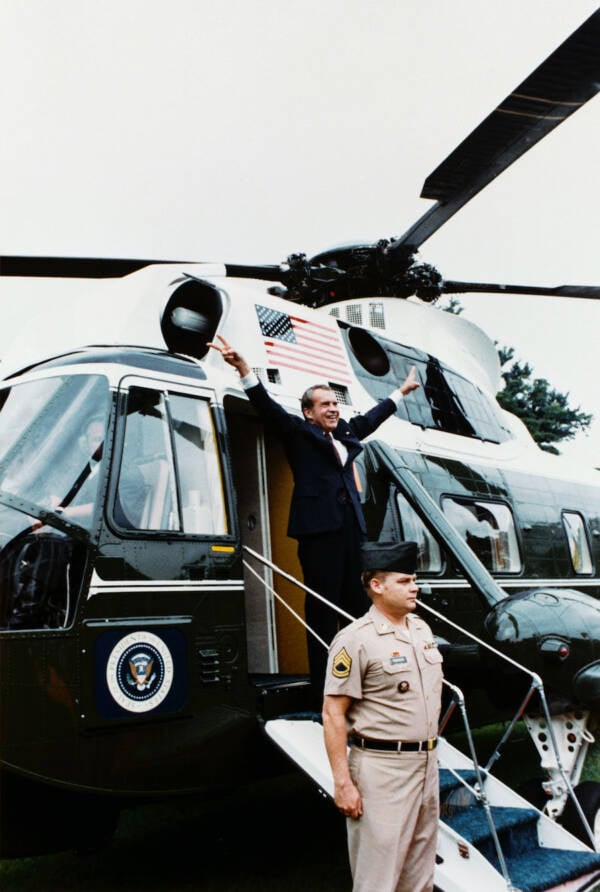
Wikimedia CommonsRichard Nixon’s final farewell to the American public as president before flying off after his resignation. 1974.
A $25,000 cashier’s check intended for the Nixon reelection campaign fund had been deposited in the bank account of Bernard Barker back in April 1972. The reporters then kept digging. Before long, a picture emerged.
The Nixon reelection money was essentially a slush fund used as a source for cash to finance the Plumbers’ illegal operations. The revelations contained in subpoenaed Oval Office audio recordings, the testimonies from conspirators like Hunt and McCord, and, ultimately, Nixon’s retaliatory responses against the press finally turned public opinion against him.
Facing almost certain impeachment and pressure from his own party, Richard Nixon resigned on August 8, 1974, an unprecedented and still unrepeated anomaly in the history of the U.S. presidency.
Why Watergate Happened
The “mainstream” narrative of the Watergate break-in is nice and succinct. The Nixon campaign decided to spy on its competition to gain an advantage in the upcoming election. This isn’t wrong or untrue, but it is oversimplified.
Despite all of Nixon’s shortcomings and the vocal reaction of his political opposition, he started the 1972 campaign with a lead in the national polls and didn’t lose it, despite the increasing stream of discoveries and revelations that would become infamous as the “Watergate scandal.”
In many ways, the full picture of what had happened was not clear until well into Nixon’s second term. One of Nixon’s best allies was timing. The early stories about the break-in were eclipsed by the coverage of the tumultuous Democratic National Convention. Then, the lede was buried further when the Democratic vice-presidential candidate resigned when it was revealed he’d previously undergone electroshock treatment for his mental health issues.
These factors, combined with an aggressive campaign and public reluctance over McGovern’s platform, made the election of 1972 notably one-sided. No one expected McGovern to win and even the DNC chairman Lawrence F. O’Brien complained about the widely-held view that Nixon was “unbeatable.”
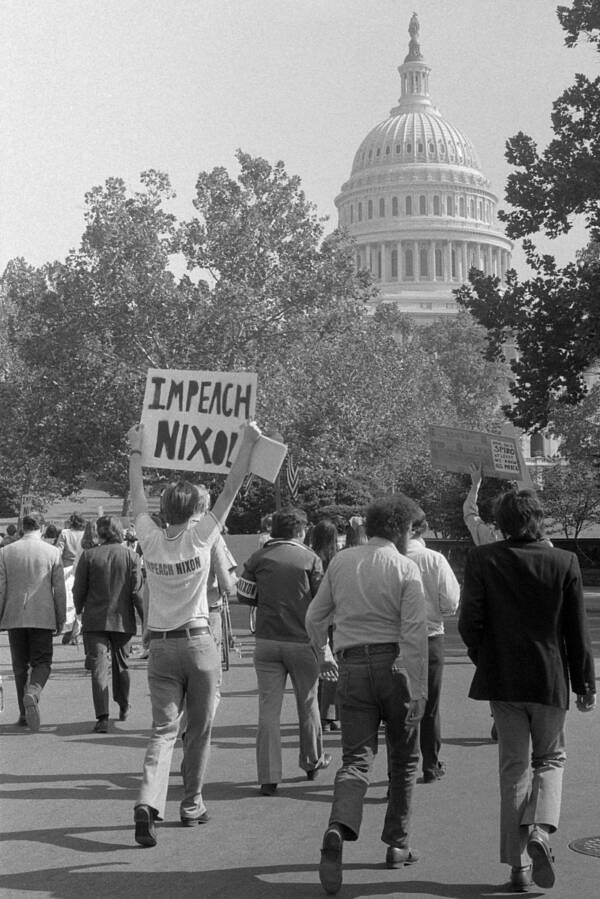
Wikimedia CommonsImpeachment protestors in Washington D.C. Circa 1972.
But, if there was truly no way that Nixon could have lost the election, why would he risk everything by allowing the break-in to happen?
According to the testimony of team members, the Plumbers’ goal wasn’t to learn more about the McGovern campaign. What the real mission was supposed to be differs depending upon which Plumber you believe.
In 2001, G. Gordon Liddy claimed that he had been deceived about the real goal of the burglars — that they were looking for any evidence the DNC had that linked Nixon’s White House counsel’s future wife to a call-girl ring.
Hunt maintained that the break-in was an effort to find evidence of communist campaign funding in the DNC office. This claim appears to have retained a lasting power for some of the other Plumbers.
In his 1974 Vanity Fair article, Martinez seemed to support a similar position, saying, “We all had heard rumors in Miami that McGovern was receiving money from Castro. That was nothing new. We believe that today.”
Another popular theory argues that the Plumbers were looking for evidence that DNC chairman Lawrence F. O’Brien knew about Nixon’s personal financial dealings with billionaire Howard Hughes.
Supposedly, Hughes had given Nixon $100,000, passed through an intermediary to go unnoticed, which allegedly went partly toward Nixon’s home in Florida. If this were true, it is possible that O’Brien could have done something with this information to harm Nixon’s campaign.
Another ironic possibility is that the Plumbers may have been looking for information about themselves, investigating how much the Democrats might have already known about their illegal activities and previous break-ins.
What Watergate Means
Richard Nixon’s resignation removed some of the intensity from the investigations that the Watergate break-ins had instigated. Nixon was never convicted of any crime nor proven to have actually authorized the burglary. Still, his successor, President Gerald Ford, pardoned him of any crimes he may have committed while in office, a widely unpopular decision.
Ford said that his “full, free, and absolute” pardon of Richard Nixon was his effort to restore national unity after divisions that came about due to Watergate. However, the Plumbers were not so lucky.
So long as Nixon had remained in office, the Plumbers’ best hope had been eventually earning pardons for their actions and meanwhile enjoying whatever benefits their connections could afford them in prison. But once it became clear that Nixon’s cause was lost, nearly all of the Plumbers started cooperating with investigators in exchange for reduced sentences.
James McCord was one of the first to flip, writing a tell-all letter that “broke the case wide open.” For that, he only served four months in prison. Liddy, the last holdout who infamously refused to cooperate with prosecutors, spent the longest time in prison at about four and a half years.
As for the burglars who broke into the Watergate complex, they each served about 15 months in prison for the crime. And Hunt served about 31 months.
But in total, 69 people were implicated in the crime — including multiple top aides to the president — and 48 people were convicted of crimes related to Watergate. However, in many ways, the Plumbers bore the brunt of the scandal, as the fall guys who had done the dirty work.
In a way, the lack of a satisfying conclusion seems to be part of Watergate’s lasting horror and appeal. Its sloppiness, its inexplicable errors, and alarmingly brazen connections to American intelligence services almost demand us to witness it, the civic equivalent of a multi-car pile-up.
Interestingly, that appears to be the same way in which it is settling into collective culture decades after its events. Watergate now means something more than simply the historical event that it describes.
To this day, the media regularly renames an unfolding news story and elevates it into a unique class of events. These are the “-gate” scandals, a list that includes: Bridgegate, Deflategate, Gamergate, Elbowgate, Emailgate, Russiagate, Weinergate, and Pizzagate, among many, many others.
Most of these controversies and conspiracy theories provoke strong and bitter opinions, but, upon reflection, it appears that is at least part of the common thread for inclusion in the category. The other part is that it causes a loss of faith or a change in perspective about something which is familiar or even comforting — like football, video games, or a presidency.
In all, this suggests that Watergate is still a collective trauma in the American political consciousness. A story that shocked the nation with mysterious men and uncomfortable questions that consumed everyone’s attention for years, ended a presidency, and then was abruptly over. But Americans didn’t have all the answers, and they did not seem to feel better.
Or, at least that’s one takeaway from this observation: For a large portion of the American population, when something shocking and outrageous occurs — no matter what or where it is — they still think of Watergate. It set and has remained the standard for political scandal since 1972.
After learning about the Watergate Plumbers, go inside the shocking story of how President Nixon may have prolonged the Vietnam War for political gain. Then, discover the history of impeached presidents in the United States.





